Russian Auto Cannabis Strain Week-by-Week Guide

- 1. Grow specifications
- 2. Grow set up
- 3. Germination and seedling stage | week 1
- 4. Vegetative phase | week 2
- 5. Transition (pre-flower) | week 3
- 6. Early flower | weeks 4-5
- 7. Mid flower (bulk phase) | weeks 6-7
- 8. Ripening and harvest | week 8
- 9. Yield and smoke report
- 10. In conclusion
With Russian Auto, we’ve given the ultimate revamp to the world-famous classic. This autoflower doesn’t mind harsh weather and easily fends off pest attacks which makes her one of the most resilient outdoor plants in our collection. Indoor growers will appreciate the strain’s incredible speed and short stature, and everybody will fall in love with her balanced effect and creamy flavor.
In our week-by-week growing guide, we cover all aspects of Russian Auto cultivation, her seed-to-harvest timeline, and her weekly progress through all grow stages and different stages of flowering. We do our best to help you decide on the best methods of growing this classic variety.
1. Grow Specifications
The genetics of the original White Russian hail from both Asia and Latin America. To this explosive mix of 70% Indica and 30% Sativa, we have added a healthy dose of Ruderalis to create a short-statured, sturdy, and fast-flowering plant. It seldom grows taller than 60–80 cm (24–31 in) and may rush through her life cycle in as little as 8 weeks.
Despite the discreet size and extra-short flowering time, the yields are generous: 400–500 gr/m2 (1.3–1.6 oz/ft2). The per-plant production outdoors is more modest at 50–130 grams (2–4 oz), but only because the plants don’t grow into gigantic trees and don’t take all summer.
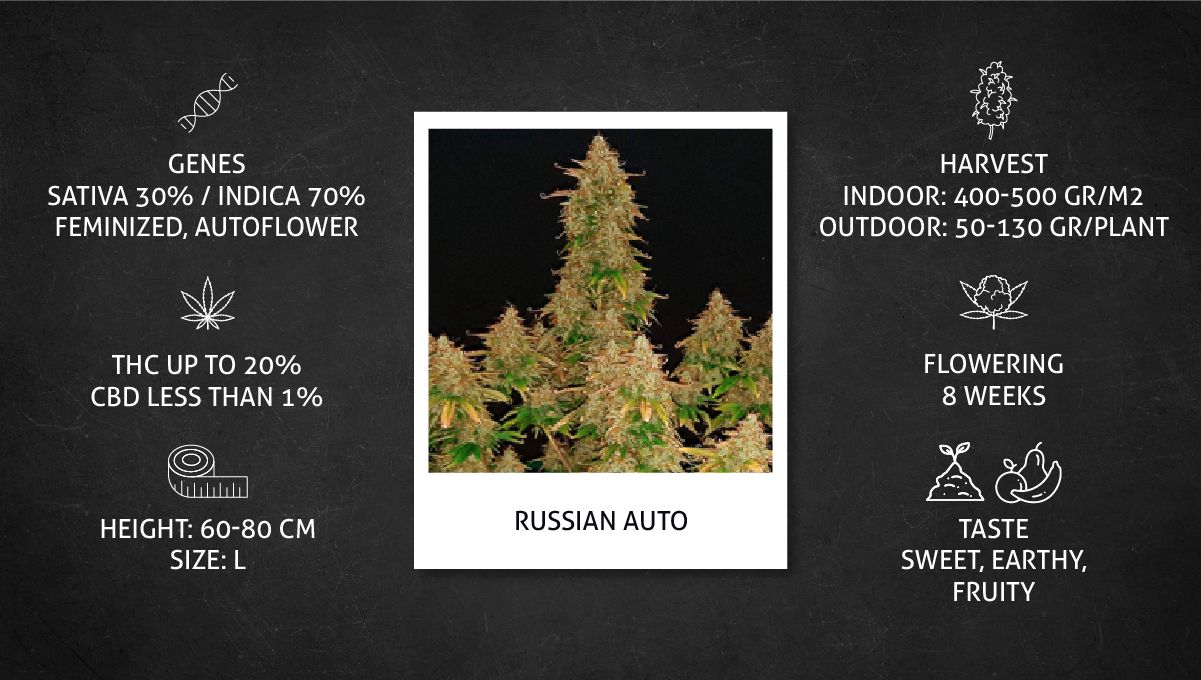
The buds get quickly covered in resin and pack up to 20% THC, producing a potent smoke dominated by a blissful relaxation with a touch of cerebral euphoria. The taste of sweet tarts, fruit, and earth is very enjoyable. Although she boasts a high THC content, this psychoactive cannabinoid isn’t the only phytochemical responsible for her pleasant effects. The same terpenes that provide her moreish flavors and lovely scent also directly contribute to the subjective effects that she offers. Together, this cocktail of molecules converges to relax every muscle in the body, while flicking on a creative and philosophical switch in the mind.
As you can probably guess, this variety makes perfect smoke during late afternoons and evenings after the demanding tasks of the day are over. Pack these buds into bongs, joints, and bowls just before reading a book, painting, or writing music to really zone into the experience.
2. Grow Set Up
For our week-by-week growing guide, we have chosen a gardener with the nickname Mr_Weeds_Auto. He grows his autoflowers in a perfectly average setup like thousands of amateur horticulturists out there: a 2’x4’ tent, a 300W LED light by Vivosun, an exhaust fan, a charcoal filter, and oscillating fans to stir things up.
| Grow Space: | 0.74 m2 (8 ft2) | Pot Size: | 11.35 l (3 gal) |
|---|---|---|---|
| Seed to Harvest: | 8 weeks | Medium: | Potting soil |
| Flowering: | 5 weeks | Nutrients: | Synthetic |
| Light Cycle: | 18/6 | pH Levels: | 6.1–6.3 |
| Light Type: | LED | Day Temperature: | 26–27°C (79–81°F) |
| Watts Used: | 300 | Humidity: | 57% ↘ 50% ↘ 45% |
And since it’s hard to judge a strain by just one grow cycle, we’re going to occasionally compare this one with two others.
3. Germination And Seedling Stage | Week 1
To germinate a cannabis seed, all you need to do is keep things moist, warm, and dark. You can achieve this with dozens of germination techniques: from the most basic, such as straight into the medium, to some very elaborate rituals, like the one our grower chose.
| Plant Height: | 2“ (5 cm) | Humidity: | 57% |
|---|---|---|---|
| Distance to Light: | 36“ (91 cm) | Water per Day: | 0.07 gal (0.25 l) |
| Day Temp: | 79°F (26°C) | pH: | 6.1 |
| Night Temp: | 68°F (20°C) | Smell: | None |
He first soaked his one seed in pH-balanced water for 48 hours. Strictly speaking, pH is only relevant for the efficiency of nutrient uptake. And since no nutrients are used at this stage, don’t worry about pH just yet and simply use any water of drinking quality.
Pre-soaking weed seeds, especially for so long, isn’t without its risks: you might drown the bean by depriving it of oxygen. So either soak it for something like 12 hours or put it between wet paper towels from the start. Either way, you’ll save yourself some time.
When exposed to moisture, the seed cracks and grows a taproot. Most growers wait till it’s about half an inch long before planting it, again about half an inch deep. Some gardeners plant just deep enough so that the “helmet head” is at surface level.
But in this case, it’s certain that the outer shell of the seed won’t come off on its own, so you’ll have to remove it with your fingers later. Planting the seed deeper raises the chances of the shell coming off on its way up.
Simply planting a seed in watered soil without any pre-soaking works too, and it usually takes about 60 hours to see a sprout. At least, with fresh and vigorous seeds.
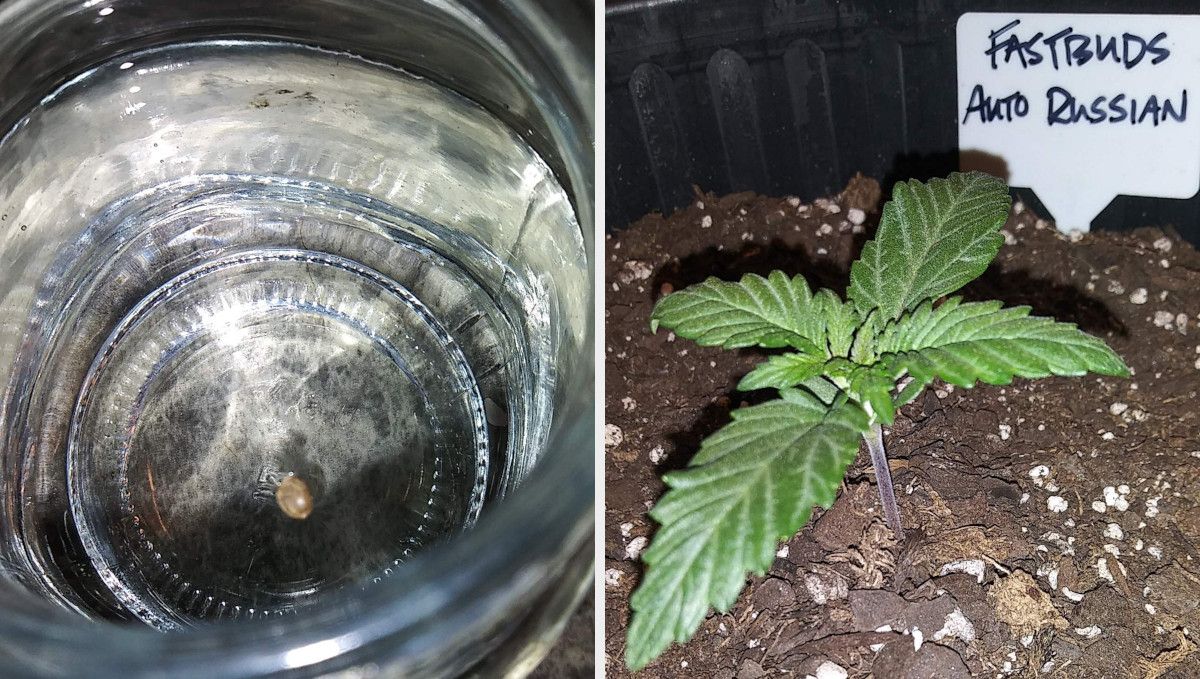
If you have pre-moistened the soil before planting and the pot is large enough, your autoflower can survive her first week without any watering. The roots will just grow deeper and deeper in search of moisture. But of course, most growers either spray the surface of the soil or water lightly around the base of the stem every couple of days.
And since soil mixes come pre-loaded with nutrients, you don’t have to add any plant food just yet. Simply make sure that your seedling isn’t thirsty. She’ll also appreciate warm temps and high relative humidity. If your RH is too low, you can raise it by using a humidity dome or by misting regularly. From here, many growers cross their fingers and hope that their small vulnerable seedlings manage to make it through this relatively risky portion of the growing cycle. However, by harnessing the power of microbes, there are several steps you can take to vastly increase the chances of success during this period, from boosting germination rates to improving seedling health and vitality. Firstly, inoculant your seed with arbuscular mycorrhizal fungi (by simply adding some propagules into the hole when you drop your seed into the soil), you’ll create a symbiotic relationship between your plant and a highly beneficial life form.
These fungi will physically fuse to the roots and increase the reach of this critical system over time. During the seedling stage, these species of fungi help to defend seedling roots against potentially devastating diseases. Next up, you can also leverage the power of Korean Natural Farming, otherwise known as KNF. A particular prep, known as LAB, uses a combination of rice rinse water and milk to culture lactic acid bacteria. These species are highly beneficial to plants, including during the seedling stage. Apply this mixture to seeds, and you’ll see an increase in their germination rates. During sprouting, they’ll also help to defend your seedlings against common pathogens that can lead to disasters if they manage to gain a foothold.
4. Vegetative Phase | Week 2
In the second week from seed, autoflowers change gears: they stop directing all their energy to the roots and start producing new leaves at an accelerated rate. And as a seedling stops being a seedling and turns into a strong young plant, she can handle the higher light intensity. So you can turn up the dial on your LED or decrease the distance to the plant top.
| Plant Height: | 4“ (10 cm) | Humidity: | 57% |
|---|---|---|---|
| Distance to Light: | 18“ (46 cm) | Water per Day: | 0.07 gal (0.25 l) |
| Day Temp: | 79°F (26°C) | pH: | 6.1 |
| Night Temp: | 68°F (20°C) | Smell: | None |
In this run, Russian Auto looked spectacular. She not only had lush deep-green foliage but quite a few well-developed side branches too. The grower attributed this to the strong genetics and the fact that he managed to keep the conditions so stable.
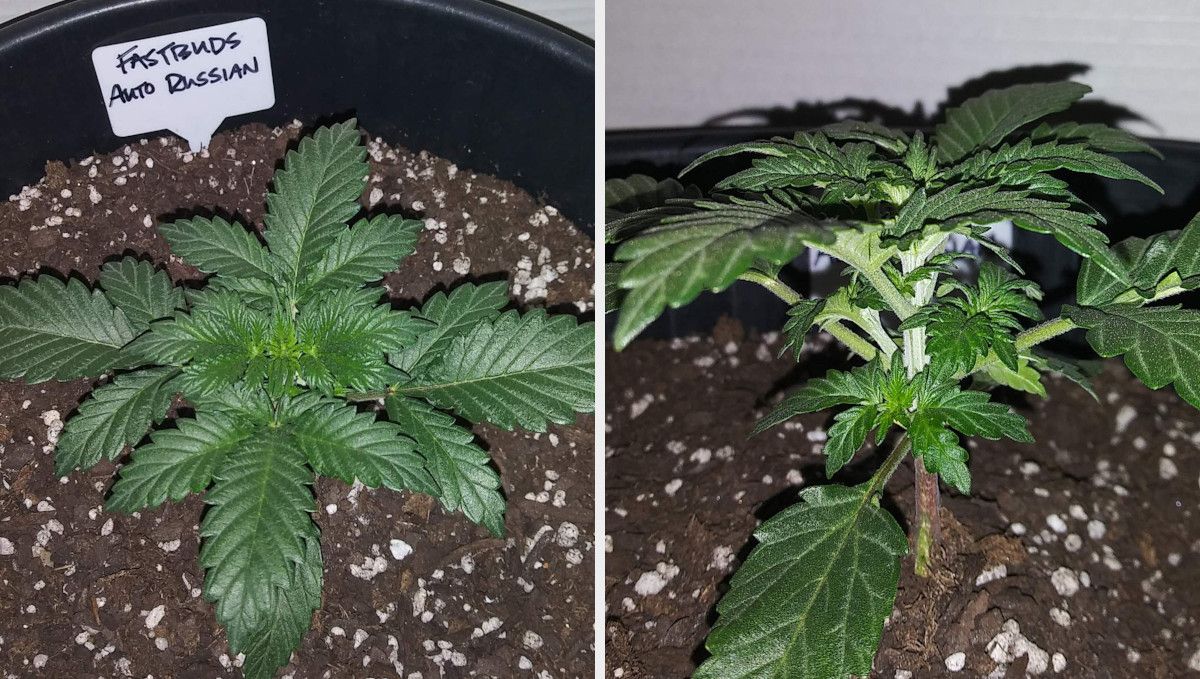
He also introduced nutrients for the first time. Although it’s not an absolute must in soil, many gardeners don’t wait until their cannabis drains the medium of all preloaded ferts and start giving some with water.
This grower decided that his girl was well-fed on nitrogen, and his very first nutrient mix was the one more suited for flowering. It consisted of the following three products:
- General Hydroponics FloraMicro; all essential micronutrients,
- General Hydroponics FloraBloom; phosphorus and calcium plus magnesium and sulfur,
- Botanicare Cal-Mag Plus; calcium, magnesium, iron, and trace minerals.
The first two products are part of a 3-pack GHE set that in itself is sufficient from seed to harvest. Of course, more experienced growers use additional supplements, but those don’t guarantee you better results if you don’t know exactly what you’re doing. If you’re new to this game and make your feeding schedule too complicated, you simply risk burning your weed.
5. Transition (Pre-Flower) | Week 3
Sometime toward the close of the first month, autoflowers enter the pre-flowering stage. To see the first pre-flowers, you need to inspect the nodes—the sites on the stem from which fan leaves and side branches grow. Pre-flowers look like tiny greenish-white hairs that grow in twos.
You don’t have to change the light cycle to initiate flowering, and there’s no need to make changes to the conditions or the feeding schedule just yet. A vigorous vegetative growth still continues, and cannabis still needs a diet suitable for the vegetative phase.
| Plant Height: | 8“ (20 cm) | Humidity: | 57% |
|---|---|---|---|
| Distance to Light: | 24“ (61cm) | Water per Day: | 0.13 gal (0.5 l) |
| Day Temp: | 79°F (26°C) | pH: | 6.2 |
| Night Temp: | 68°F (20°C) | Smell: | Weak |
Even among the fastest modern autoflowers, Russian Auto is unique in that she can enter the flowering stage so early—after only two weeks from seed. In week 3, she not only displayed the first hairs at the nodes, but the tops also looked like they were starting to form buds. It’s very easy to see with a naked eye: the new leaves that grow here are now thin and yellowish and interspersed with female hairs.
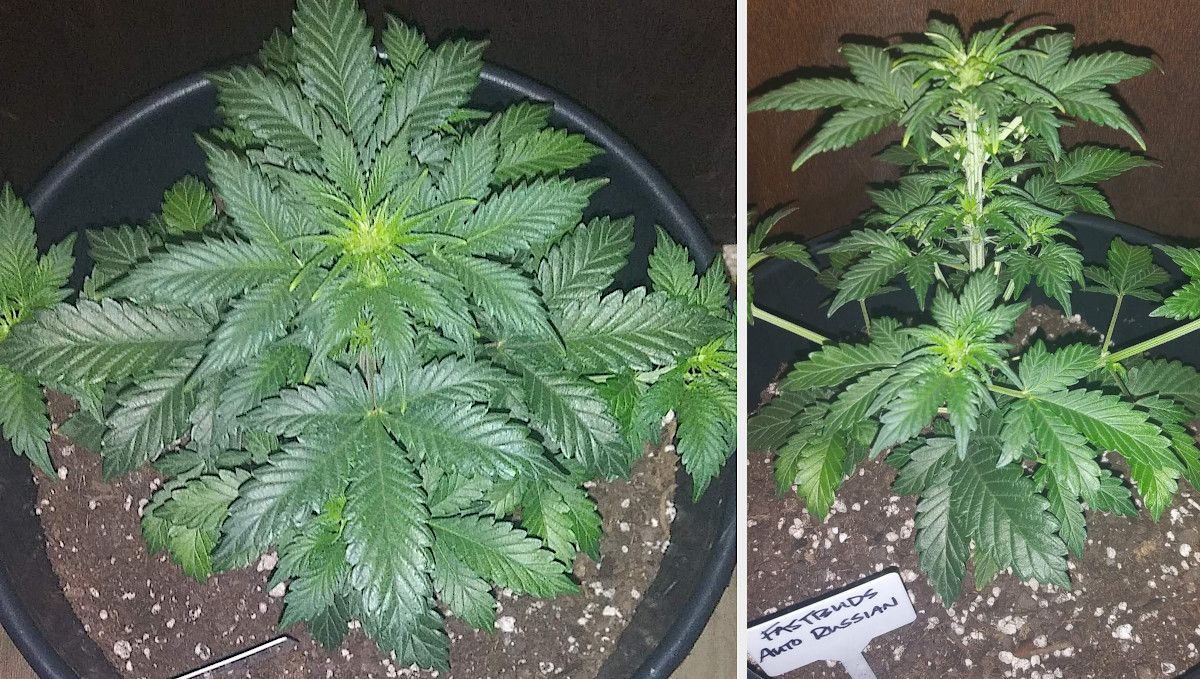
As you may notice in the pic above, the leaves are a too deep shade of green. Of course, one reason is the Indica-leaning genetics, but maybe Russian Auto has also a strong reaction to nitrogen and needs less of it than other autoflowers. At least, this grower decided to cut down on N a bit and also raise the lights. These measures indeed helped to make his little lady look perkier.
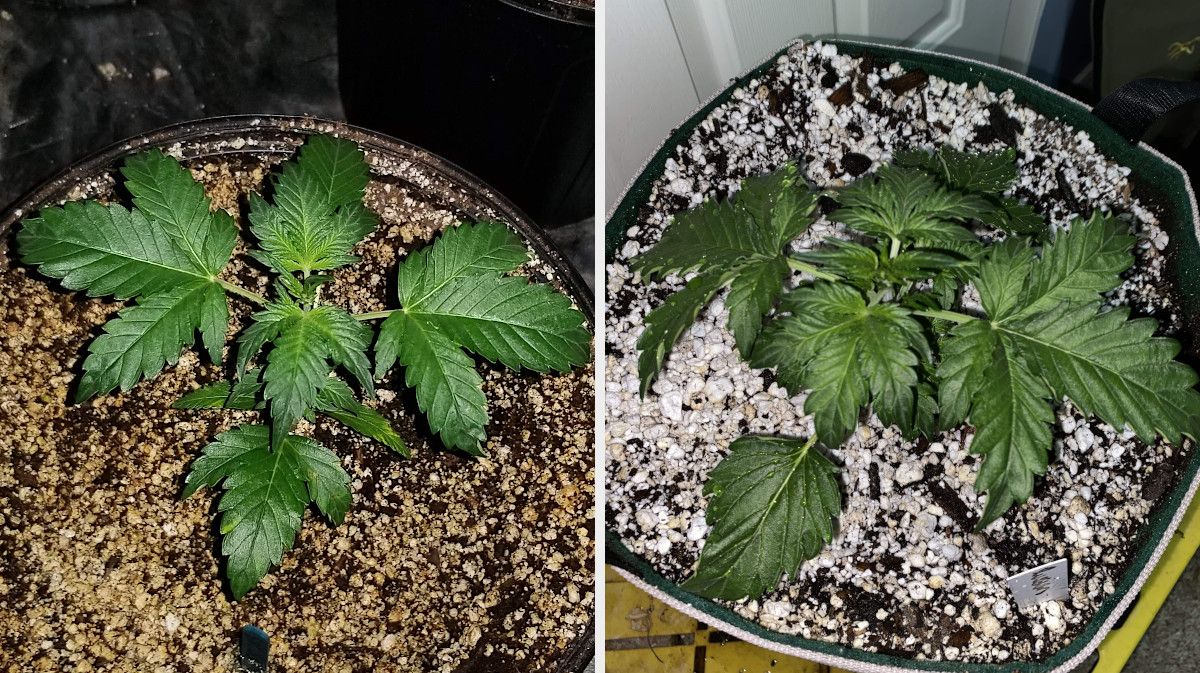
The Russians in the other two grow cycles also looked dark green as if they were overfed on nitrogen. It’s good when genetics is so predictable because you always know what to expect and can prevent any issues.
6. Early Flower | Weeks 4-5
The first two weeks of cannabis flowering stages are the time when the most noticeable change is not the budding but the so-called flowering stretch. At this point in the timeline, the stem and the branches elongate, making the plant at least 50% taller. And some varieties can stretch 2 or 3 times.
| Plant Height: | 14–21“ (34–52 cm) | Humidity: | 57% ↘ 50% |
|---|---|---|---|
| Distance to Light: | 24“ (61cm) | Water per Day: | 0.13 gal (0.5 l) |
| Day Temp: | 79–81°F (26–27°C) | pH: | 6.3 |
| Night Temp: | 68°F (20°C) | Smell: | Normal |
This Russian Auto revealed a very comfortable structure: with the central cola towering head and shoulders above the rest but with many quite long side branches as well. The internodes were long enough not to create a tangled mess, and the gardener had only to remove a few fan leaves here and there and pluck the dying yellow ones at the very bottom.
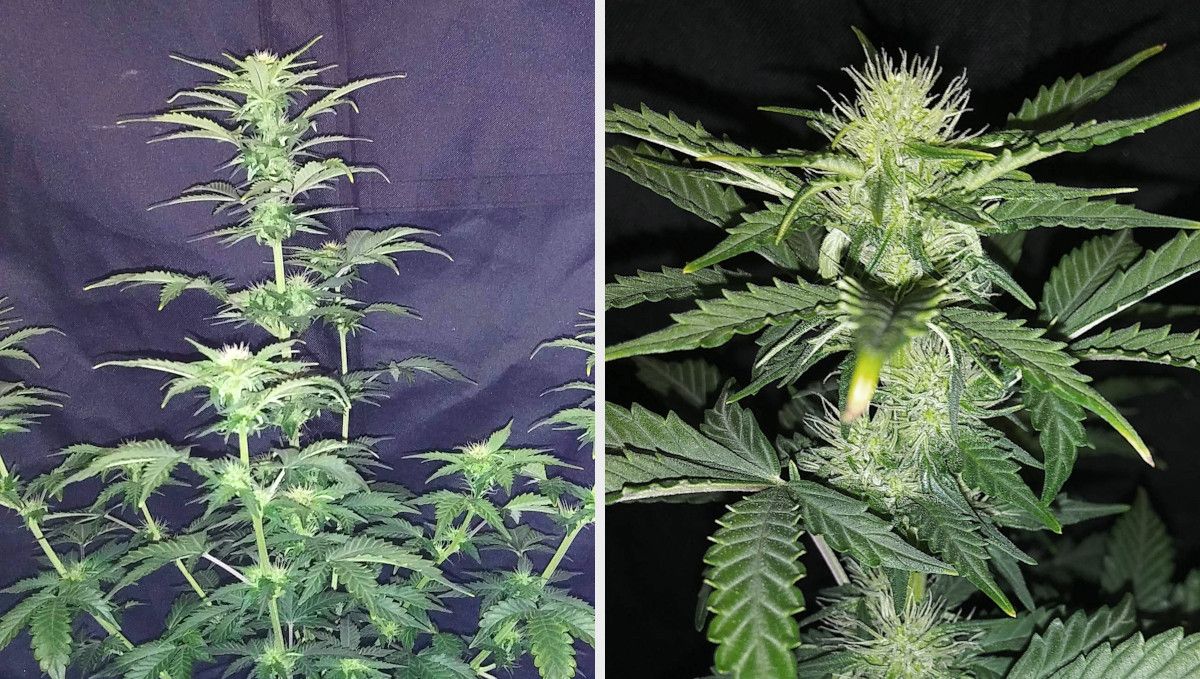
He could already see the first trichomes on the calyces, and the smell in the tent was no longer to be ignored. After a slight N overfeeding in veg, the guy was still going light on the nutes, alternating between plain water and medium-strength feeding solution. And here is the complete nutrient schedule for the whole life cycle:
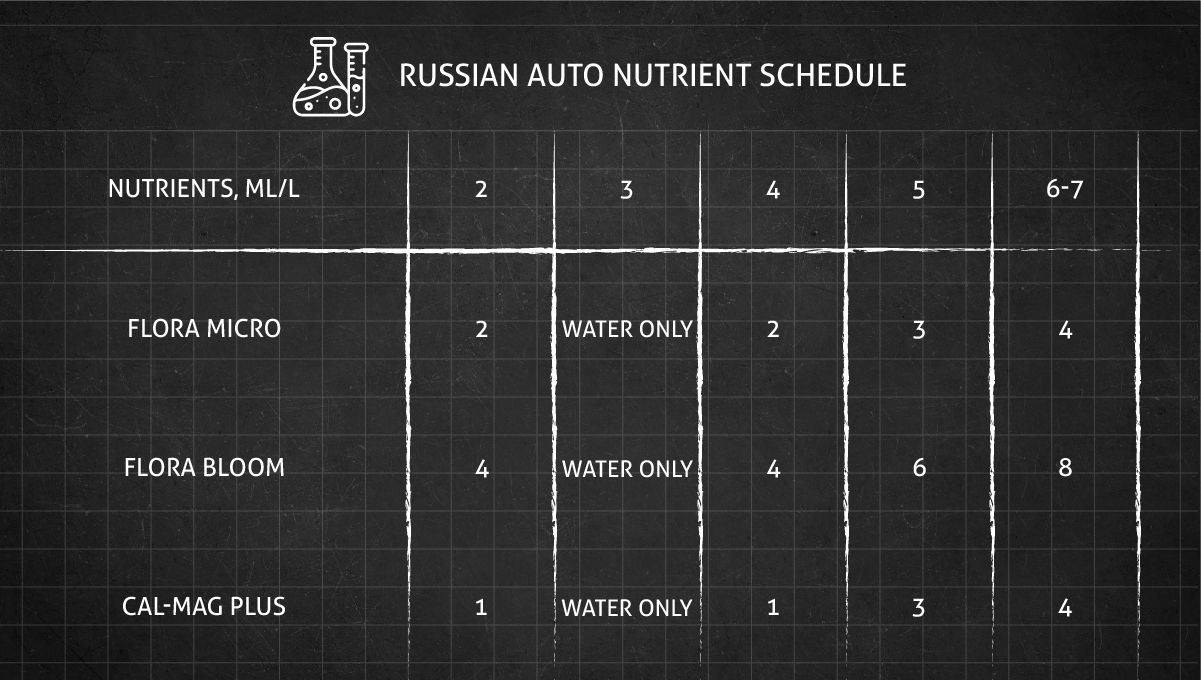
7. Mid Flower (Bulk Phase) | Weeks 6-7
Now, 4 weeks into flowering, bud formation is well underway, and cannabis can benefit from lower temps. In this case, the opposite happened: it became a bit hotter in the tent, but despite this, Russian Auto chugged along just fine.
| Plant Height: | 21“ (52 cm) | Humidity: | 57% |
|---|---|---|---|
| Distance to Light: | 24“ (61cm) | Water per Day: | 0.33 gal (1.25 l) |
| Day Temp: | 81°F (27°C) | pH: | 6.1 |
| Night Temp: | 70°F (21°C) | Smell: | Normal ↗ Strong |
As you may notice from the tables, the grower let pH fluctuate a little (but always kept it in the acceptable range which is 6.1–6.5 for soil). Such slight fluctuations are even beneficial because different nutrients have different uptake ranges.
The last two weeks of feeding were on cruise control. The stretch was over, and you can see the whole progress of Russian Auto in terms of size in the chart below:
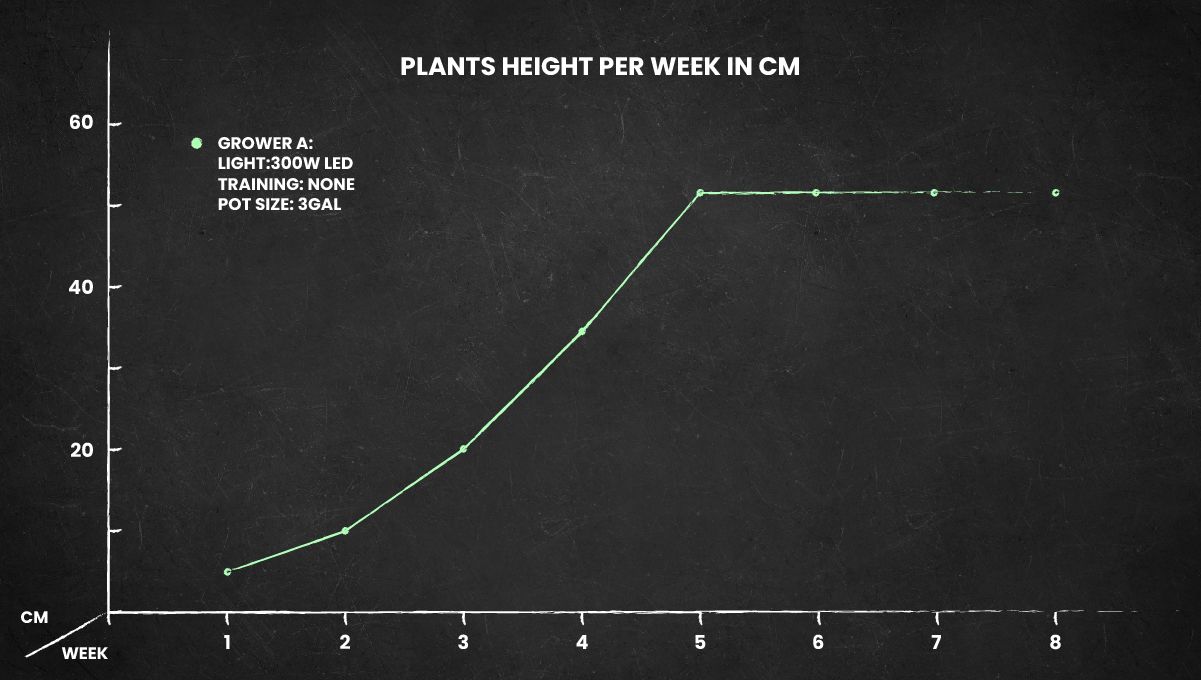
The only thing the grower had to do—besides fertigating—was defoliating older leaves that were getting yellow due to the lack of nitrogen. In autoflower flowering stages, it’s good to keep your plants N-deficient like this. It facilitates the fade which means less hay-smelling chlorophyll in the final product. Besides, too much N interferes with flowering, making the buds smaller.
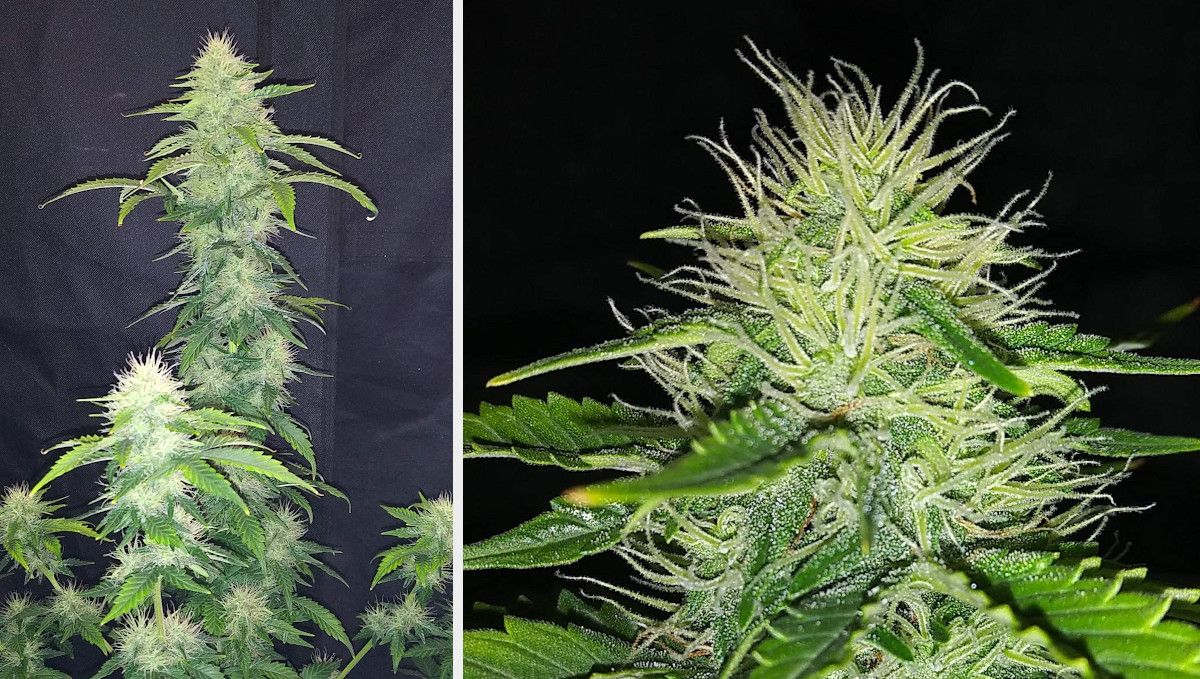
As you see in the pic, the colas on this Russian Auto were quite chunky and solid. In the other two grows that we’ve reviewed, there was some foxtailing. Foxtailing is usually cannabis’ reaction to heat. All the more reason to keep the temps down in flower.
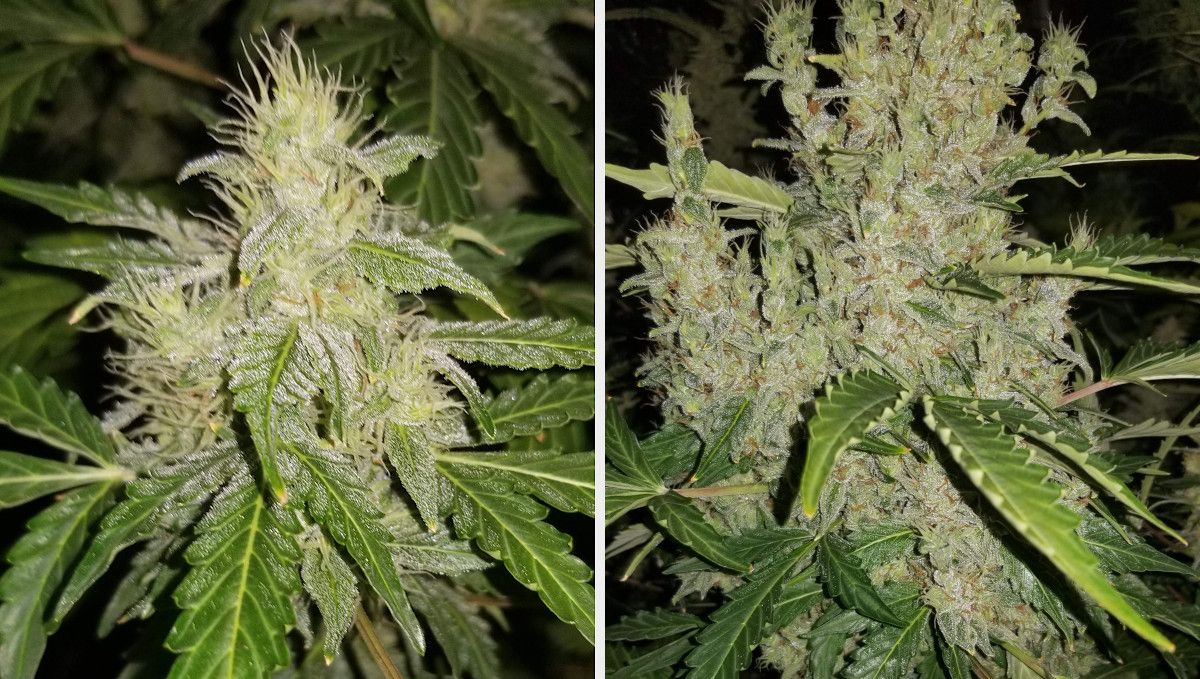
9. Ripening And Harvest | Week 8
The last week or two in the life cycle of a cannabis plant is a risky period because now the buds get so fat and dense that you can easily get mold or bud rot inside them. Mold looks like ultrafine grey webbing, and bud rot usually starts near the stem and then spreads to the nearest calyces, making them brown and mushy. To prevent these problems, ensure good air circulation and keep the relative humidity somewhere between 35 and 45 percent.
| Plant Height: | 21“ (52 cm) | Humidity: | 45% |
|---|---|---|---|
| Distance to Light: | 24“ (61cm) | Water per Day: | 0.33 gal (1.25 l) |
| Day Temp: | 81°F (27°C) | pH: | 6.1 |
| Night Temp: | 70°F (21°C) | Smell: | Strong |
At this point in the timeline, the name of the game is trichome watching. When you see that many of the pistils have changed color from white to orange (or some more exotic hue), take a hand microscope and inspect the trichs. Your perfect harvest window is when they have all changed from clear to milky and there are some ambers as well.
And prior to that—when the trichomes are only starting to get cloudy—start with the final flush. It means giving your plants plenty of plain water so that your autoflower uses up the remainder of nutrients stored in the medium and reaches the finish line clean. It’s very important for the quality of your smoke.
When growing in soil, thorough flushing takes up to 2 weeks. In DWC and soilless mediums, one week is enough.
In this grow, the guy chopped his Russian Auto on day 63 from seed. The trichome coverage was very good and the size of the main cola was impressive.
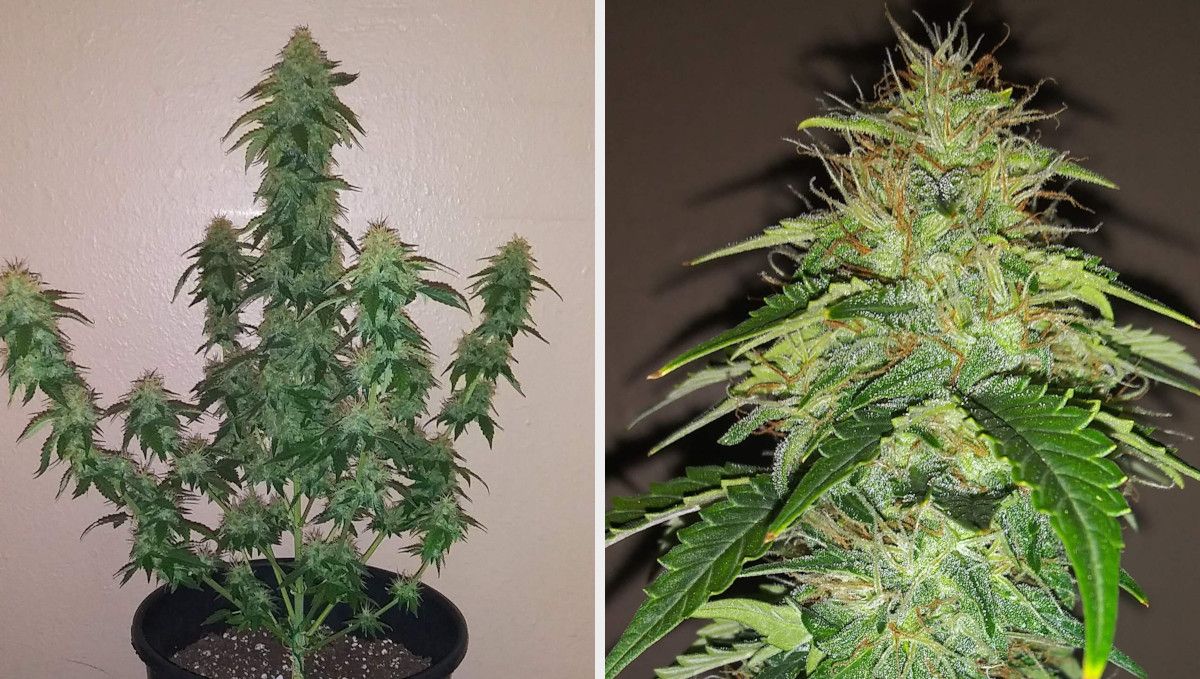
Of the other two growers in our review, one harvested his girl at exactly the same age while the other waited for an extra week. Which is still incredibly fast by any metric.
10. Yield and Smoke Report
This untrained 9-week-fast Russian Auto performed very well, bringing her owner 1.36 oz (38.6 g) of closely trimmed dry buds. The grower noted that the bottom nuggets were the densest he’d ever seen. And he had never grown a main cola as big as this one.
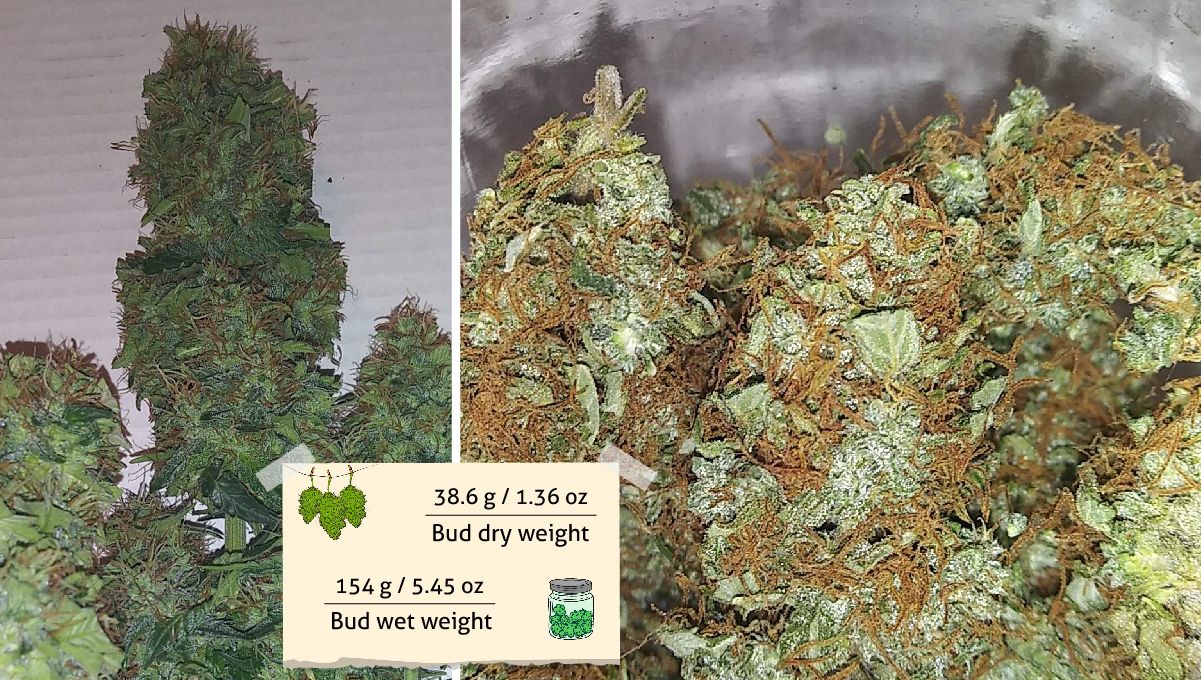
He dried the plant whole (and lightly trimmed) for 9 days which was enough for her to lose the hay smell. Then he cured the buds for a month. Not rushing through the process of curing brings out the best in smell and taste and also makes the smoke more potent.
Very smooth, sweet, with a citrus sour taste. The high was just right, not too overwhelming to the point where you want to go to sleep, but it was top-notch quality.
Mr_Weeds_Auto
The other two guys in our review rated their Russian Autos even higher, noting a potent and long-lasting effect that was almost entirely in the head, save for a brief narcotic finish. And they also enjoyed the sweet and fruity flavor of their smoke, reminiscent of some old-school chronic.
11. In Conclusion
White Russian is such a long-lived classic for a reason, and FastBuds’ autoflowering version retains all her best qualities. Russian Auto is superfast: you’ll be sampling your first nuggets as other strains in your grow are still inching to the finish line. She might be sensitive to nitrogen in veg, but other than that this variety is perfectly low-maintenance.
The added bonus is her compact size—an indispensable trait for smaller indoor setups and stealthy outdoor grows. And to crown it all, the quality of the finished product is top-notch, and isn’t it all we really care about? Happy growing, everyone!
External References
- Response of essential oil hemp (Cannabis sativa L.) growth, biomass, and cannabinoid profiles to varying fertigation rates, Steven L. Anderson et al., July 2021
- Validating a predictive model of cannabinoid inheritance with feral, clinical, and industrial Cannabis sativa, American Journal of Botany, October 2020







Comments